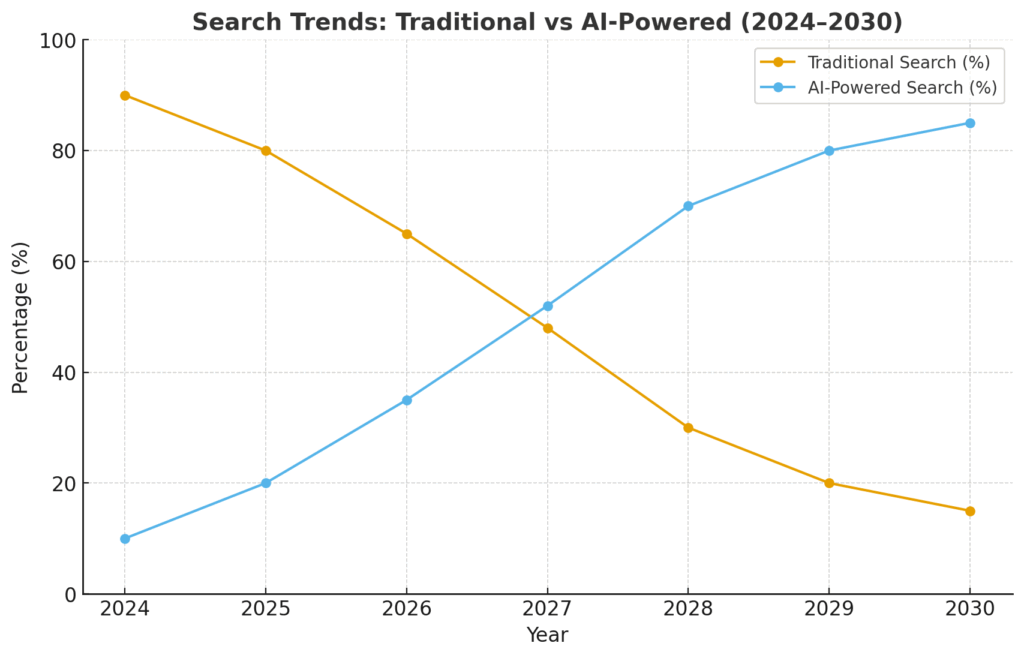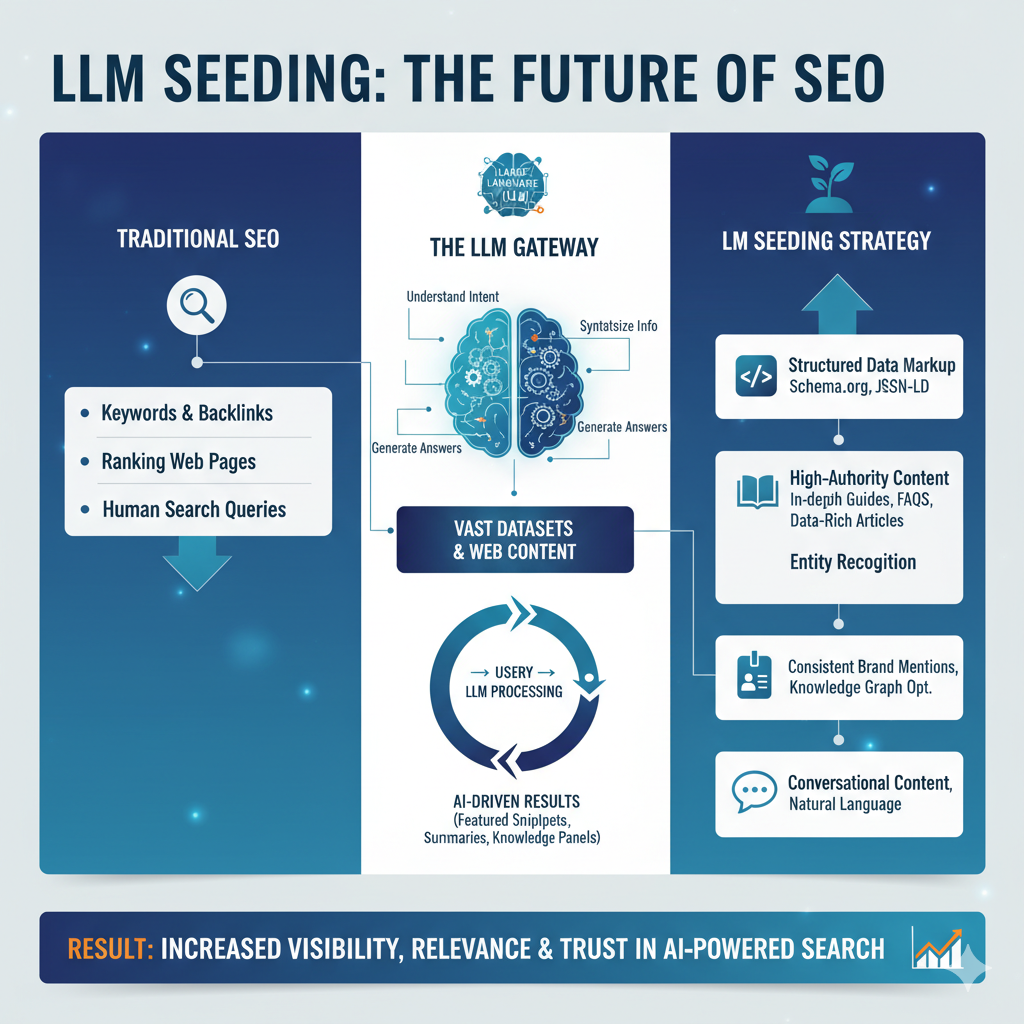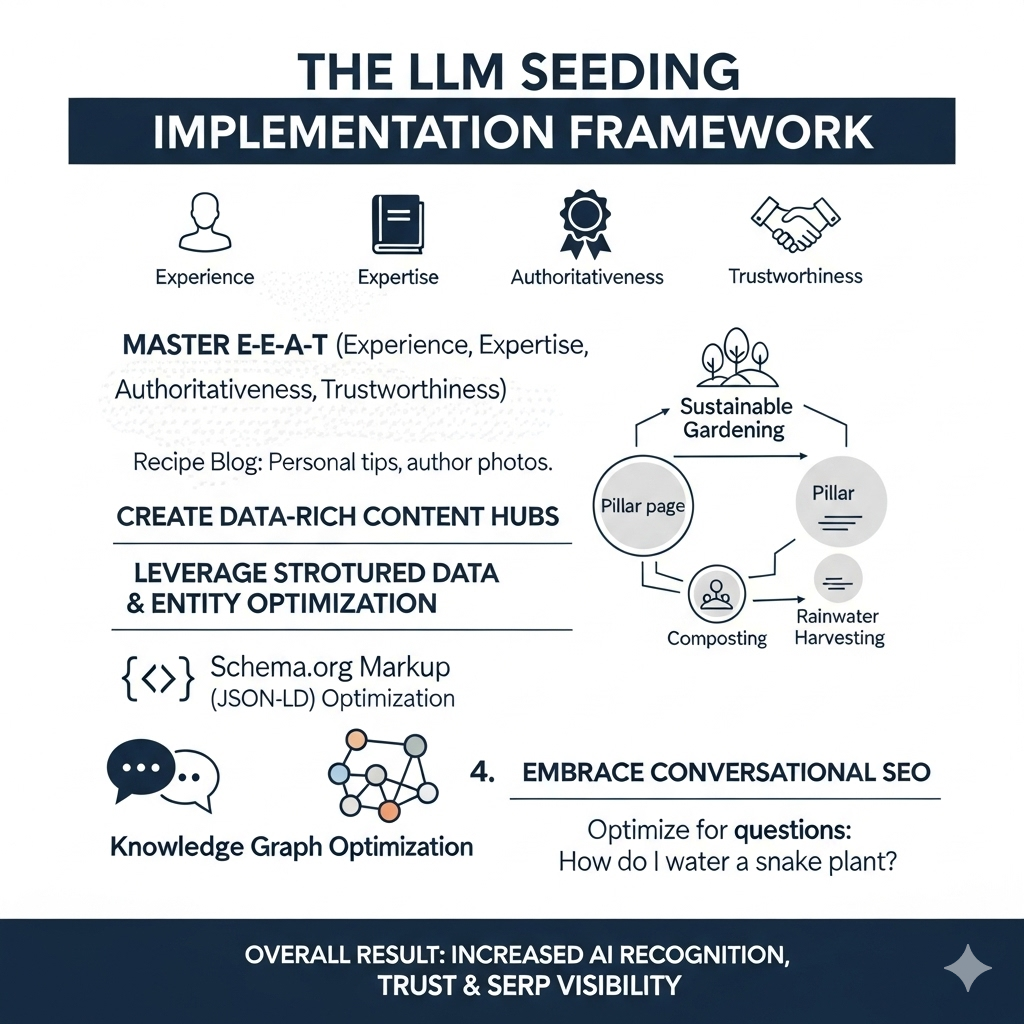Standard SEO is going out the window – website hits, backlinks and high rankings are not your main focus anymore, the future is LLM Seeding.
Maintaining basic SEO practices is still important for keywords, headings and authority but this is a critical second layer that is slowly overtaking.
AI searches are set to surpass traditional searches by the end of 2026 and the role of the common website will still change during this time.
We need to feed Gemini, ChatGPT, Grok and all the other AI systems out there with more real human data, AI needs to grow and this is by far your best way to help create the tool that will eventually (very soon) take over the world.

LLM Seeding: The New Frontier of SEO
The landscape of Search Engine Optimization (SEO) is in constant flux, but perhaps no force is reshaping it more profoundly than the rise of Large Language Models (LLMs). We’re moving beyond simple keyword matching into an era of semantic understanding and generative AI. This shift has given birth to a powerful new strategy: LLM Seeding.
What is LLM Seeding?
LLM Seeding is an advanced SEO technique that involves strategically providing context, information, and data to Large Language Models (LLMs) used by search engines (or that influence search results) to improve the visibility, relevance, and authority of your content. Instead of solely optimizing for human search queries, you’re also optimizing for the LLMs that interpret those queries, synthesize information, and often generate direct answers or summaries.
Think of it as “teaching” the AI about your brand, products, services, and expertise so that when it’s asked a related question, it can confidently and accurately point to your content as a reliable source.
How it Works: The Mechanics Behind the Magic
LLMs learn from vast datasets, processing billions of text parameters to understand language, context, and relationships between concepts. When a user asks a question, modern search engines leverage these LLMs to:
- Understand Intent: Go beyond keywords to grasp the true meaning behind a user’s query.
- Synthesize Information: Pull relevant data points from across the web.
- Generate Answers/Summaries: Often provide direct answers (e.g., in featured snippets, knowledge panels, or generative AI summaries) rather than just a list of links.
- Rank Results: Use their understanding to influence the ranking of traditional web pages.
LLM Seeding works by proactively engaging with this process. It involves creating and distributing content that is highly informative, structured, authoritative, and easily digestible by AI models. This “seeds” the LLMs with accurate information about your domain, increasing the likelihood that your content will be cited, summarized, or directly presented in AI-driven search results.

The Shifting Search Sector: From Links to Knowledge
The search sector is undergoing a profound transformation:
- From “10 Blue Links” to Direct Answers: Users increasingly expect immediate, precise answers, often delivered directly in the search results page (SERP) without needing to click through.
- Conversational Search: Voice search and AI assistants encourage more natural, conversational queries, demanding that content be optimized for understanding nuanced language.
- The Rise of Generative AI: Search engines are integrating generative capabilities, offering summaries and direct content creation based on web data.
- Knowledge Graph Dominance: Search engines are building ever-more sophisticated knowledge graphs—networks of real-world entities and their relationships. Being a recognized entity within this graph is paramount.
How Traditional SEO Has Changed (and What Remains)
Traditional SEO, focused on keywords, backlinks, and technical optimization, isn’t totally dead, but its emphasis has shifted dramatically:
- Keywords: Still important, but now seen through a lens of user intent and semantic relevance rather than exact match density. Long-tail, conversational keywords are gaining prominence.
- Backlinks: Remain a strong signal of authority, but the context and relevance of those links, and the entities they connect, are more critical than ever.
- Technical SEO: Foundational. A fast, mobile-friendly, crawlable site is essential for both humans and AI models to access and understand your content.
- Content Quality: Elevated to an art form. Content must be comprehensive, authoritative, trustworthy, and satisfy complex user needs. E-E-A-T (Experience, Expertise, Authoritativeness, Trustworthiness) is the guiding star.
The biggest change: Traditional SEO aimed to get your page to rank. LLM Seeding aims to get your information to be recognized and utilized by the AI itself, regardless of whether it’s presented as a direct link, a featured snippet, or part of a generative answer.
How to Implement LLM Seeding: Ideas and Examples
Implementing LLM Seeding requires a multi-faceted approach, focusing on content quality, structured data, and entity optimization.
1. Master E-E-A-T (Experience, Expertise, Authoritativeness, Trustworthiness)
LLMs are trained on human-generated data, and they are designed to prioritize high-quality, trustworthy sources. Demonstrating E-E-A-T is foundational.
- Experience: Showcase real-world usage or personal insights.
- Example: A recipe blog not just listing ingredients, but sharing personal cooking tips, common pitfalls, and variations based on experience.
- Expertise: Have content created or reviewed by verified experts.
- Example: A medical site clearly identifying authors with medical degrees and citing peer-reviewed studies.
- Authoritativeness: Build a reputation as a go-to source in your niche.
- Example: Consistently publishing in-depth, original research or data that other sites reference.
- Trustworthiness: Ensure transparency, accuracy, and security.
- Example: Clear privacy policies, secure website (HTTPS), and readily available contact information.
2. Create Comprehensive, Data-Rich Content Hubs
LLMs thrive on comprehensive information. Instead of thin articles, create pillar pages and content clusters that cover a topic exhaustively.
- Example: For “sustainable gardening,” a pillar page might cover an overview, linking out to cluster content on “composting techniques,” “organic pest control,” “rainwater harvesting,” etc. Each of these sub-topics would also be deeply explored.
- Actionable Tip: Answer not just the primary query but also related “People Also Ask” questions and latent semantic indexing (LSI) keywords within your content.

3. Leverage Structured Data and Entity Optimization
This is arguably the most direct way to “seed” an LLM. Structured data (Schema.org markup) provides explicit clues to search engines and LLMs about the meaning and relationships of your content.
- Schema.org Markup: Use JSON-LD to tell search engines what your content is.
- Examples:
Article,Product(with reviews, pricing),FAQPage,HowTo,Organization,LocalBusiness, andAuthorSchema. - Why it works: It helps LLMs understand entities (people, places, things), their attributes, and relationships, making your data more accessible for knowledge panels and direct answers.
- Examples:
- Knowledge Graph Optimization:
- Consistent Brand Mentions: Ensure your brand name, product names, and key personnel are consistently referred to across the web.
- Wikipedia/Wikidata Entries: If applicable, having a Wikipedia page for your entity or key personnel significantly boosts entity recognition.
- Crunchbase/Industry Directories: Listing your company in relevant, authoritative directories reinforces your entity’s presence.
4. Embrace Conversational SEO
LLMs are designed to understand and generate natural language. Optimize your content for how people actually talk and ask questions.
- Long-Tail & Question-Based Keywords: Focus on phrases like “how do I [solve a problem]?” or “what is the best [product for X]?”
- Natural Language Answers: Provide direct, concise answers to these questions within your content, ideally at the beginning of sections. This is prime material for featured snippets and AI summaries.
- FAQ Sections: Dedicated FAQ sections with clear questions and answers are excellent for LLM seeding. Use
FAQPageSchema to maximize their impact. - Use of Synonyms and Semantic Variations: Don’t keyword stuff. Instead, use a rich vocabulary that covers the semantic breadth of your topic.
Conclusion
LLM Seeding is not a replacement for traditional SEO exactly, but an evolution that is taking over. It’s about thinking beyond keywords and links to strategically “teach” the AI that powers modern search. By focusing on E-E-A-T, comprehensive content, structured data, entity optimization, and conversational language, you can position your brand to thrive in an increasingly AI-driven search ecosystem. The future of SEO is about being understood by machines, so they can better serve humans.
Note: If you are thinking that you will use AI to create these new information rich QA pages – don’t! Use it to spell check or format but that’s all.
Also don’t over optimise content for AI, it must remain human focused at the same time.
AI is trained to look for AI content and it will always choose human created knowledge and hands on experience over any auto generated content.
Core Strategies for LLM Seeding
1. Publish High-Quality, Authoritative Content
- Follow E-E-A-T principles (Experience, Expertise, Authoritativeness, Trustworthiness).
- Provide first-hand knowledge, data, or insights that AI models can’t easily find elsewhere.
- Avoid thin or duplicate content.
2. Use Structured Data & Schema Markup
- Implement schema.org markup (FAQ, HowTo, Product, Organization, Article).
- Ensure entities (people, products, places) are clearly tagged.
- Structured data helps both search engines and LLMs interpret meaning.
3. Build Topic Clusters & Content Hubs
- Create a central “pillar” page for each core subject.
- Link to supporting pages that go into detail.
- This helps models understand your authority across an entire topic.
4. Write for Conversational Queries
- Anticipate questions users might ask an AI assistant.
- Include natural-language FAQs.
- Use clear, direct answers followed by supporting detail.
5. Optimize for Clarity and Trust
- Cite credible sources and statistics.
- Use bylines with author credentials.
- Keep content accurate and updated.
Extra Tips for Maximizing AI Search Visibility
6. Leverage Multimedia & Multimodal Content
- Include images, charts, and videos with descriptive alt text.
- Future AI models process more than text, so rich media increases visibility.
7. Focus on Entities, Not Just Keywords
- Ensure people, organizations, and concepts are consistently referenced with clear names.
- Link to authoritative profiles (e.g., Wikipedia, LinkedIn, company bios).
8. Monitor AI Search Behavior
- Test how different LLMs answer queries in your niche.
- Note whether your brand or competitors are mentioned.
- Adjust your content to fill gaps or add clarity.
9. Balance Optimization With Human Value
- Don’t “stuff” pages with AI-friendly phrases — write naturally.
- Prioritize human readability. If humans find it useful, LLMs are more likely to adopt it.
10. Track Success With New Metrics
- Instead of only tracking search rankings, measure:
- Inclusion in AI-generated answers
- Brand mentions in summaries
- Growth in direct assistant-driven traffic
11. Be Mindful of Risks
- Misinformation risk: Poor-quality content may spread through LLM answers.
- Over-optimization: If your content looks like it’s written only for machines, it may be ignored.
- Data ownership: Consider copyright, licensing, and how you want your content to be reused.
Quick Checklist for LLM Seeding
✅ Publish authoritative, original content (show experience & expertise)
✅ Use schema markup (FAQ, HowTo, Product, Article)
✅ Create content hubs with pillar + cluster pages
✅ Add FAQs and conversational Q&A
✅ Keep content accurate, up-to-date, and cited
✅ Include multimedia with descriptive alt text
✅ Emphasize entities (people, brands, topics)
✅ Monitor AI assistant outputs in your niche
✅ Write for humans first, optimize for AI second
✅ Track mentions in AI answers and generative search
Best Tools to Support LLM Seeding and AI Search Visibility
Optimizing content for AI-powered search and large language models (LLMs) requires more than just publishing articles — you also need to monitor, audit, and track how your content is being interpreted. Below is a breakdown of good software categories and specific tools that can help.
Ahrefs is still the best tool for traditional search monitoring and optimisation. It can be combined to work with any of the tools listed below.
AI Visibility Tracking Tools
These help you see when and how your brand shows up in AI-generated responses.
- SE Ranking (AI Visibility Tracker) – Monitors brand visibility in generative answers with competitor comparisons.
- Semrush (AI Search Visibility Checker) – Tracks prompts and brand mentions in AI-powered search.
- SurferSEO (AI Tracker) – Provides prompt-level insights and trends in AI mentions.
- Authoritas – Tracks visibility across AI snippets, FAQs, and search summaries.
- Profound AI – Focused on generative engine optimization and deep AI search metrics.
AI Mentions & Prompt Monitoring
These tools simulate queries and analyze how your content is reflected in AI answers.
- Semrush AI Toolkit – Monitors which prompts trigger your brand.
- SurferSEO AI Tracker – Breaks down mentions by query type and frequency.
- Profound AI – Adds sentiment analysis to brand mentions.
Structured Data & Schema Auditing Tools
Ensuring your schema is correct is critical for AI models to understand your site.
- Google Rich Results Test – Validates schema markup for common content types.
- Schema.org Validator – General-purpose structured data testing.
- Sitebulb – Crawls entire sites for missing or broken schema.
- Screaming Frog – Identifies schema issues at scale and checks consistency.
- WordLift Structured Data Audit – Focused on entity tagging and structured content.
Content & Prompt Testing Tools
These help refine your content by testing queries and seeing how AI models respond.
- Semrush AI Checker – Lets you run test prompts and check response content.
- SurferSEO AI Reports – Provides prompt-driven content audits.
- Custom Prompt Testing – Manual checks in ChatGPT, Gemini, or Claude to verify how your site appears.
How These Tools Help With LLM Seeding
- Audit structured data regularly with validators and site crawlers.
- Track brand visibility in AI-generated responses through AI trackers.
- Benchmark against competitors to see where you’re missing out.
- Refine your content strategy with prompt tests and visibility reports.
- Measure changes over time to confirm improvements in AI search presence.
Things to Keep in Mind
- Coverage is limited: Each tool only tracks certain LLMs or AI search features.
- Prompts evolve quickly: AI models update, so visibility may fluctuate.
- Mentions don’t equal traffic: Track conversions alongside brand mentions.
- Filter out noise: Not every mention provides business value.
- Balance cost vs ROI: Many advanced tools are priced for agencies, so smaller businesses may need to combine free tools with manual testing.
Final Thoughts
LLM seeding isn’t just about writing content — it’s about ensuring your content is seen, understood, and used by AI assistants. Using visibility trackers, schema auditing tools, and prompt testing software will give you the insights you need to adapt your content strategy for the future of AI search.
LLM Seeding & AI Visibility Tools Comparison
| Tool / Platform | Category | What It Does Best | Ideal For |
|---|---|---|---|
| SE Ranking (AI Visibility Tracker) | AI Visibility Tracking | Monitors brand mentions in AI answers, tracks competitors | Businesses wanting a clear view of AI visibility trends |
| Semrush (AI Search Visibility Checker) | AI Visibility & Prompt Monitoring | Tracks prompts, brand mentions, and AI search coverage | SEO teams managing multiple brands |
| SurferSEO (AI Tracker) | Prompt Monitoring & Reporting | Provides prompt-level insights and visibility trends | Content marketers refining strategy |
| Authoritas | AI Snippets & FAQ Tracking | Tracks AI snippets, FAQ mentions, and local visibility | Agencies and enterprise websites |
| Profound AI | Generative Engine Optimization | Deep AI search metrics and sentiment analysis | Brands wanting advanced analytics |
| Google Rich Results Test | Schema Validation | Tests common schema types for errors | Quick checks of structured data |
| Schema.org Validator | Schema Validation | General-purpose structured data validator | Developers and web admins |
| Sitebulb | Site-Wide Schema Auditing | Crawls large sites for schema coverage | Technical SEO teams |
| Screaming Frog | SEO Crawling & Schema Auditing | Identifies missing or broken schema at scale | Larger sites with complex structures |
| WordLift Structured Data Audit | Entity Optimization | Focused on tagging and entity clarity | Content teams targeting LLM seeding |






